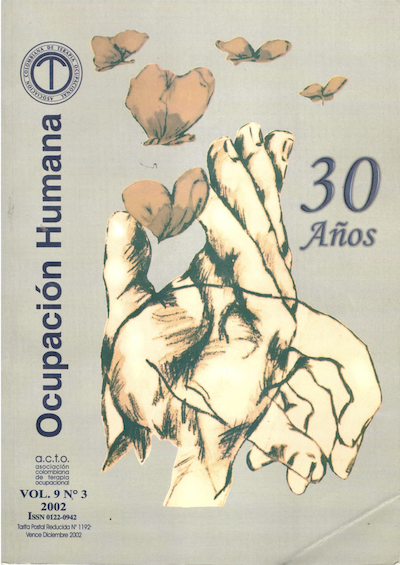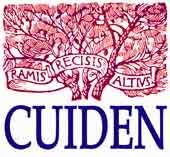Programa de actividades cotidianas basado en la teoría del procesamiento sensorial
DOI:
https://doi.org/10.25214/25907816.544Palabras clave:
procesamiento sensorialResumen
Este artículo presenta una revisión sobre los principios de los programas basados en el concepto de desarrollo y procesamiento sensorial, particularmente, los propuestos como medida de manejo integral al infante con y sin limitación funcional o problemas de interacción. A partir de ellos, se plantea un programa cotidiano relacionado con la experiencia en el medio colombiano.
Descargas
Referencias bibliográficas
Ayres, J. (1972). Sensory integration and learning disorders. Los Ángeles: Western psychological services.
Ayres,J.(1974).The Development of sensory integrative theory and Practice:A collection of the works of Jean Ayres. Rockville, M.D.: American Occupational Therapy Association.
Cermak, S., Morris, M., & Koomar, J. (1990). Praxis on verbal command and imitation . American Journal of Occupational therapy, 44 (7), 641-645.
https://doi.org/10.5014/ajot.44.7.641
Daems, J. (1994). Reviews of reach in sensory Integration International.
DeGangi, G. A., Berk, R. a & Larsen, L.A (1980). The measurement o f vestibules - based functions in preschool children. American Journal of Occupational therapy, 34, 452-459.
https://doi.org/10.5014/ajot.34.7.452
Dunn, W., (1994). Performance of typical children on the sensory profile: Zn item analysis. American Journal of occupational therapy , 48(11), 967-974.
https://doi.org/10.5014/ajot.48.11.967
Koomar,j. y Friedman, B.(1992b).The hidden Senses. Your Muscle Sense. Rockville, MD: THE American Occupational Therapy Association. Neurorehabilitation: A multisensory approach.
Farber, S. (De) (1982). Philadelphia: Saunders.
Fischer, A., Murray, E y Bundy, A. (1991). Sensory integration theory.and practice, Philadelphia: E A. Davis.
Frick, S. (1992). Respiration tape (cassette recording). Boulder, CO: Bell curve Records. Hafts, B. (1989). Providing family - centered occupational therapy services. Sensory
Integration Special Interest Section Newsletter, 12, 1-3.
Kimball, J. (1990).The emphasis's on integration no sensory. American. Journal of Mental Retardation, 92, 423-424.
Kosco, B.(1993).Fuzzy thinking. The new science ofescape. Lexington MA: Lexington Books.
Milkman, H., y Sunderwirth, S. (1987). Craving for ecstasy. The consciousness and chemistry of escape. Lexington MA: Lexington Books.
Montague,A.(1989).Touching: The human significance of skin. New York:Columbia University Press.
Murphy, M. (1993). The future of human nature. Los Angeles: Jeremy R Thatcher/perigee.
Otter,P. Ritcher, E. y Frick,S. (1995).MORE. Integrating the mount with sensory and postural function. Llugo, MN: PDP press.
Oliver, B. (1990). The social and emotional issues of adults with sensory defensiveness. Sensory integration Special Interest. Section Newsletter, 13, 1-3.
Omstein, R., y Sobel, D. (1987). The heading brain. Breakthrough discoveries about how the brain Keeps us healthy New York: Simon & Schuster.
Reisman, J., y Hanschu, B. (1992). Sensory Integration Inventory.-Revised for individuals with developmental disabilities. Llugo, MN: PDP press.
Richter, E. y Colangelo, E. (1992). Proceeding of the Sensory Integration Symposium
Tseg, M. y Cermak, S. (1993). Ergonomic and perceptual motor aspects of handwriting . American Journal of occupational therapy, 47(10) 919-926.
https://doi.org/10.5014/ajot.47.10.919
Wilbarger, P (1971). The identification, diagnosis and remediation of sensoriomotor dysfunction in primary school children. Title 111 ESEA project Report 5427. Goleta Union School District. California State Department Education.
Wilbarger, P. (1984). Planning and adequate sensory diet. Application of sensory processing theory during the first year of life. Zero to three, 5(1).
Wilbarger,P y Wilbarger, J. (1995).Sensory defensiveness and related social, emotional and neurological problems. Seminar presented in multiple locations. Denver,CO: Avanti Educational Programs.
Williams, MS. y Shellenberger, S. (1992). An introduction to ''H ow does your engine run?: the alert program for self- regulation. Albuquerque, NM: Therapy Works.
Williams, M.S. y Shellenberger S. (1994). How does your engine run? A leader's guide in the Alert program for self regulation. Albuquerque, NM: Therapy Work.
Zubeck, J. P (1979). Sensation deprivation. Fifteen years of research. New York: Appleton - century-crofts (now Appleton & Lange, Norwak, CT).
Zuckerman, M. (1991). Psychobiology of personality. New York: Cambridge University Press.
Zuckerman, M. (1994) Behavioral expressions and biosocial bases of sensation seeking. New York: Cambridge University Press
Descargas
Publicado
Cómo citar
Número
Sección
Licencia

| Estadísticas de artículo | |
|---|---|
| Vistas de resúmenes | |
| Vistas de PDF | |
| Descargas de PDF | |
| Vistas de HTML | |
| Otras vistas | |











